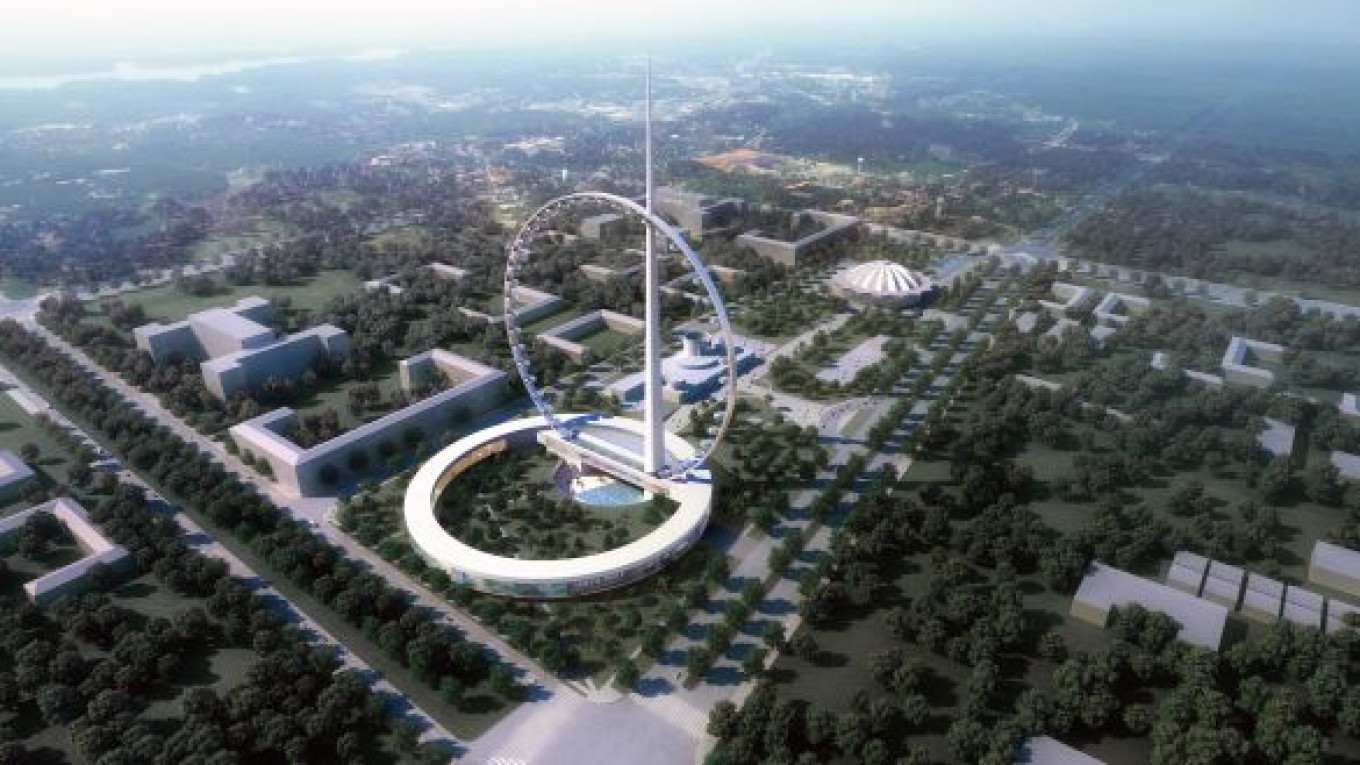While $300 million has been pledged by investors, the project design completed and a construction firm selected, the creation of what could be the world’s largest observation wheel, to be situated on a Moscow hillside, is stalled by the absence of approval from City Hall.
“As soon as the mayor’s office says OK, we are ready,” said Vitaly Kuznetsov, chief executive of Group 12, the investment and consulting firm spearheading the project.
The 220-meter tourist attraction, christened the Moscow View, has been designed with two wheels and 48 capsules capable of holding 30 people each. The vertical wheel is projected to surpass the current record holder, the Singapore Flyer, by 65 meters. A second, horizontal wheel at ground-level will hold a concert hall and art galleries.
“At the heart of the complex, we designed a reflective pool that in the winter time transforms into an ice skating rink — the Rockefeller Center comes to mind,” said Vadim Gaber, the architect for the project from the international firm Gensler.
The project was designed for a land plot in Vorobyovy Gory, next to the Bolshoi Circus, Gaber said, but it could be adapted for other locations.
All other locations would only permit smaller wheels — at Gorky Park, an attraction of no more than 90 meters could be built, said Natalya Nasonova, a member of the board of directors for Caerus, the New York-based investment firm organizing financing for the project.
“This location is the most ideal,” she said. “The city doesn’t possess a better spot.”
Following permission from the municipal government, Group 12 board director Boris Chertov believes that only 18 months will be necessary to develop the entire project. He also expects 18 months to obtain legal permission.
The organization has sent about 10 official letters to the mayor’s office since November 2010, Kuznetsov told The Moscow Times. They held consultations with the international relations department, social policies department and tourism department, receiving positive feedback from each division, he said.
After a presentation at the mayor’s office in November, however, the project faced a roadblock.
“Head architect Alexander Kuzmin is one of the most senior bureaucrats in the city and has a great amount of experience in the field of architecture,” Chertov said. “And he literally said this: ‘At the current moment in Moscow, there isn’t approval for the construction of a wheel on the locations of Vorobyovy Gory, Gorky Park and the All-
Russia Exhibition Center, VVTs.’ He meant that in the Moscow architecture department, specifically, they have not given their agreement.”
The Architecture Committee released a statement on Nov. 17, after a media frenzy had propagated the belief that the mayor’s office had all but chosen a location for the wheel. It stated that in 2002 the committee had concluded that Vorobyovy Gory’s significance as a historical and cultural site made the development of an observation wheel there impossible. It went on to say the committee re-examined the matter recently and rejected proposals to develop an observation wheel.
The committee declined to make any further comments on the matter.
The investors are trying to ameliorate any issues the Committee on Architecture may have, said Group 12 member Chertov. They plan to spend $50 million to $100 million to protect the ecological significance of the park by developing an underground parking complex and replanting trees they remove.
The Bolshoi Circus and Sats musical theater were developed in the park with special permission, Kuznetsov said. “Our project is unique and it needs a unique juridical decision. One that will not contradict the law,” he added.
White Case, the legal advisers for Group 12, is currently finalizing a proposal for the legal relationship between the city and investors, which they expect to deliver by the end of the year. If the response is positive, an auction for the rights to rent the land will be held. Group 12 hopes to sign a 25-year contract based on those agreed on rights.
The investment could be very successful. The London Eye, considered the most successful observation wheel in the world, is visited by 3.75 million paying customers each year — 750,000 more visitors than the Great Pyramids.
“In wheels we have found it is location, location, location,” said Dennis Spiegel, president of International Theme Park Services, a consulting firm that advises attractions throughout the world. “Being located at an interesting view or an area that is well known and already attracts visitors are the most important factors.”
The proposed site for the Moscow View offers an expansive view of the city, located just seven kilometers from the Kremlin. Kuznetsov said they are willing to wait as long as they have to, even five years, in order to build what he calls “the new, modern symbol of Russia.”
A Message from The Moscow Times:
Dear readers,
We are facing unprecedented challenges. Russia's Prosecutor General's Office has designated The Moscow Times as an "undesirable" organization, criminalizing our work and putting our staff at risk of prosecution. This follows our earlier unjust labeling as a "foreign agent."
These actions are direct attempts to silence independent journalism in Russia. The authorities claim our work "discredits the decisions of the Russian leadership." We see things differently: we strive to provide accurate, unbiased reporting on Russia.
We, the journalists of The Moscow Times, refuse to be silenced. But to continue our work, we need your help.
Your support, no matter how small, makes a world of difference. If you can, please support us monthly starting from just $2. It's quick to set up, and every contribution makes a significant impact.
By supporting The Moscow Times, you're defending open, independent journalism in the face of repression. Thank you for standing with us.
Remind me later.


